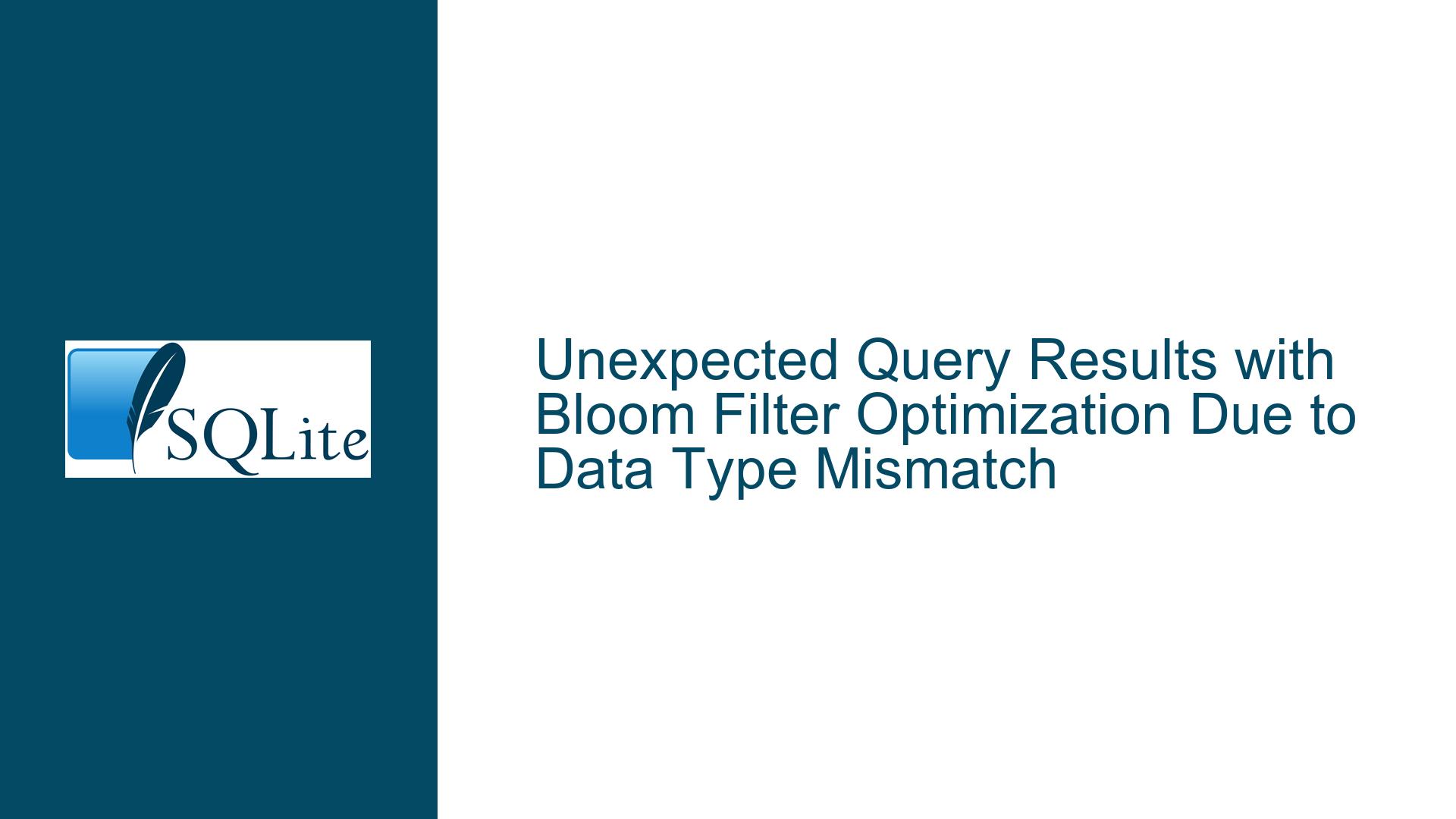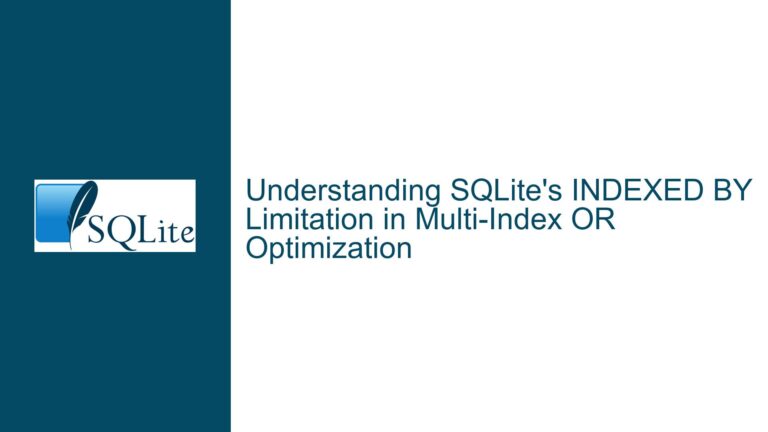Unexpected Query Results with Bloom Filter Optimization Due to Data Type Mismatch
Bloom Filter Optimization and Data Type Mismatch in SQLite Queries
SQLite’s query optimizer employs Bloom filters to reduce unnecessary row scans in complex joins involving multiple tables. A Bloom filter is a probabilistic data structure that efficiently tests whether an element belongs to a set, allowing the optimizer to skip entire blocks of data during query execution. This mechanism is particularly effective when joining large tables with indexed columns. However, when column data types and filter values are mismatched, the Bloom filter’s hash-based logic may erroneously exclude valid rows or include invalid ones, leading to incomplete or incorrect query results.
In the scenario presented, a query joining Invoice, Tasks, Events, and Plans tables via indexed columns (TaskID, EventID, PlanID) failed to return expected results when filtering on Plans.PlanID = '14011'. The EXPLAIN QUERY PLAN output revealed the use of a Bloom filter on Plans.PlanID, but the result set was incomplete. The root cause was traced to a data type mismatch: the PlanID column stored integer values, while the filter literal '14011' was provided as a string. When the literal was corrected to an integer (14011), the query returned the correct results. This demonstrates how SQLite’s type affinity system and Bloom filter implementation interact in ways that demand strict attention to data type consistency.
Root Causes of Bloom Filter-Related Query Plan Failures
1. Implicit Type Conversion and Column Affinity Mismatches
SQLite uses dynamic typing with column type affinity, meaning values are stored in flexible formats but columns have preferred storage classes (INTEGER, TEXT, etc.). When a filter literal’s data type doesn’t match the column’s affinity, SQLite attempts implicit conversions. For example, comparing an INTEGER column to a TEXT literal (PlanID = '14011') forces a runtime type coercion. While this works in simple queries, Bloom filters rely on exact hash matches derived from the original storage class. A TEXT literal passed to an INTEGER column will be hashed as a string, whereas the column’s indexed values are hashed as integers. This discrepancy causes the Bloom filter to incorrectly discard valid rows.
2. Index Invalidation Due to Type Mismatches
When a column has an index (e.g., Plans.PlanID is INTEGER and indexed), the query planner expects filter values to match the indexed data type. A mismatch forces SQLite to bypass the index and perform a full scan, but Bloom filters complicate this. If the Bloom filter is applied before type conversion occurs (e.g., during the join phase), it uses the unconverted value’s hash. This creates a paradox: the index is technically usable, but the Bloom filter’s hash-based prefiltering operates on the wrong data type, leading to false negatives.
3. Query Structure and Join Order Sensitivity
The order in which tables are joined affects Bloom filter applicability. In the example query, the INNER JOIN between Invoice and Tasks uses an OR condition (DeliveryTaskID = TaskID OR SalesTaskID = TaskID), which complicates index usage. The optimizer might prioritize joining smaller tables first (e.g., Plans), applying a Bloom filter to reduce the search space for subsequent joins. If the Bloom filter’s hash is corrupted by a type mismatch, downstream joins inherit an incorrect row subset, propagating errors through the execution pipeline.
Diagnosing and Resolving Bloom Filter Data Type Compatibility Issues
Step 1: Validate Data Types in Schema and Queries
Begin by inspecting the schema definitions for involved columns. Use the .schema command in SQLite CLI or query PRAGMA table_info([TableName]) to verify column affinities. For example:
-- Check PlanID data type in Plans table
PRAGMA table_info(Plans);
If PlanID is defined as INTEGER, ensure all filter literals match this type. Replace '14011' (TEXT) with 14011 (INTEGER).
Step 2: Analyze Query Plan with EXPLAIN QUERY PLAN
Run EXPLAIN QUERY PLAN to identify Bloom filter usage and join order:
EXPLAIN QUERY PLAN
SELECT ... [rest of the query];
Look for lines like BLOOM FILTER ON Plans (PlanID=?). If a Bloom filter is active, confirm that the filtered column and literal have identical data types.
Step 3: Test with Bloom Filters Disabled
To isolate Bloom filter impacts, disable them temporarily using:
.testctrl optimizations 0x80000 -- Disable Bloom filters in SQLite CLI
Re-execute the query. If results match expectations, the Bloom filter was likely discarding valid rows due to type mismatches.
Step 4: Explicit Type Casting in Queries
Force consistent data types using CAST:
WHERE [Plans].PlanID = CAST('14011' AS INTEGER)
This ensures the literal is treated as an integer during Bloom filter hashing.
Step 5: Schema Alignment and Index Optimization
Modify the schema to enforce strict typing or adjust indexes:
-- Recreate Plans table with STRICT type (SQLite 3.37+)
CREATE TABLE Plans (PlanID INTEGER, ...) STRICT;
Strict tables reject type mismatches, preventing implicit conversions.
Step 6: Benchmark with Representative Data
Populate tables with sample data that mirrors production scales. Test queries with and without type corrections to quantify Bloom filter efficiency gains and validate result accuracy.
By methodically aligning data types between schema definitions and query literals, leveraging explicit casting, and validating execution plans, developers can harness SQLite’s Bloom filter optimizations without sacrificing query accuracy.






